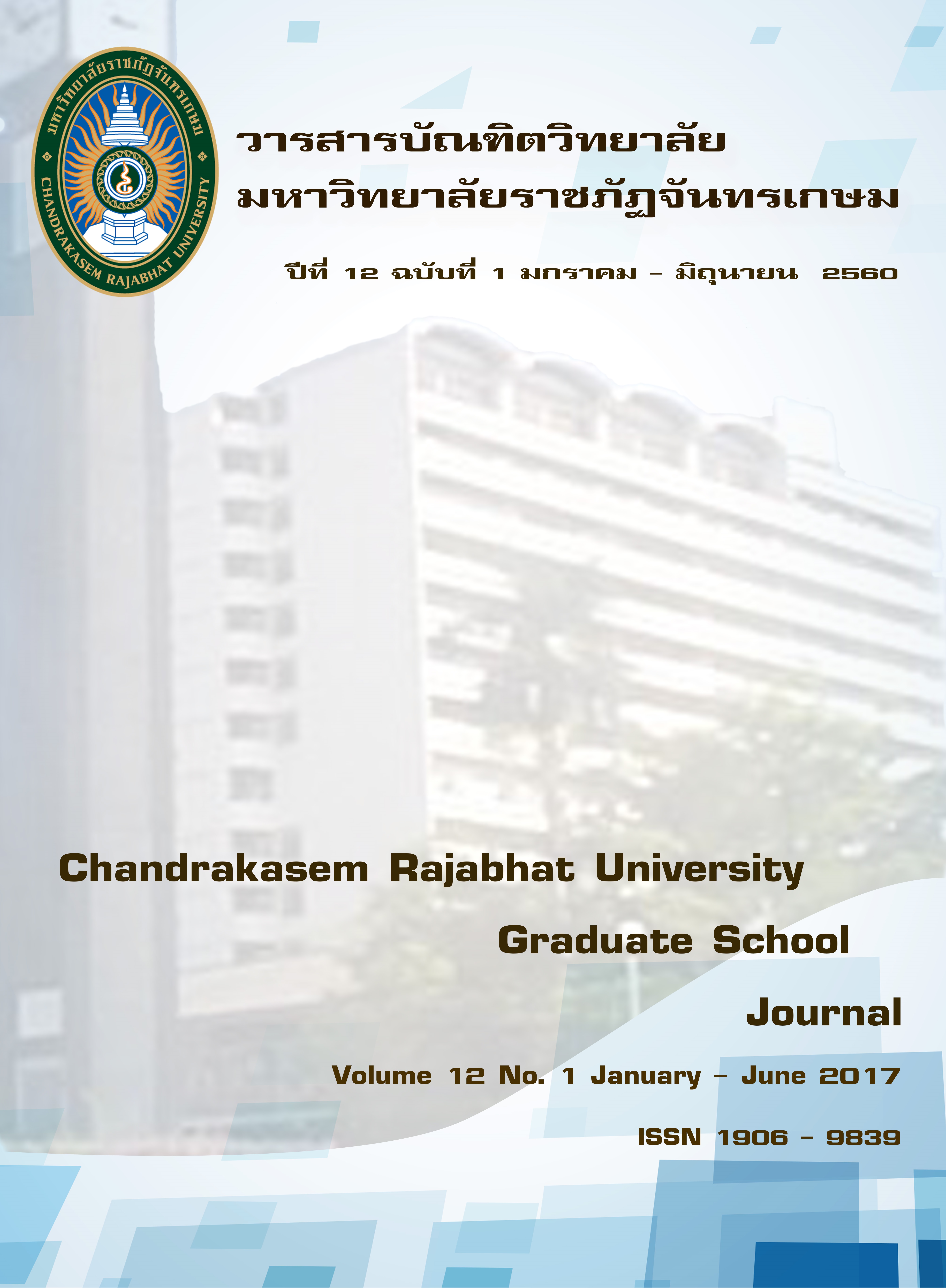ผลการใช้กิจกรรมการเรียนรู้แบบร่วมมือโดยใช้เทคนิคการจัดกลุ่มแบบคละผลสัมฤทธิ์ทางการเรียนและต่อเจตคติในการเรียนกลุ่มสาระการเรียนรู้สังคมศึกษาศาสนา และวัฒนธรรม ของนักเรียนชั้นประถมศึกษาปีที่ 6 สังกัดสำนักงานเขตพื้นที่การศึกษาประถมศึกษานนทบุรีเขต 2
Main Article Content
บทคัดย่อ
การวิจัยนี้มีจุดประสงค์เพื่อ (1) เปรียบเทียบผลสัมฤทธิ์ทางการเรียนสาระสังคมศึกษาศาสนา และวัฒนธรรม ระหว่างนักเรียนชั้นประถมศึกษาปีที่ 6 ที่เรียนโดยใช้กิจกรรมการเรียนรู้แบบร่วมมือโดยใช้เทคนิคการจัดกลุ่มแบบคละผลสัมฤทธิ์ทางการเรียนกับนักเรียนที่เรียนโดยใช้กิจกรรมการเรียนรู้แบบปกติ (2) เปรียบเทียบเจตคติในการเรียนกลุ่มสาระการเรียนรู้สังคมศึกษา ศาสนาและวัฒนธรรม ระหว่างนักเรียนชั้นประถมศึกษาปีที่ 6 ที่เรียนโดยใช้กิจกรรมการเรียนรู้แบบร่วมมือโดยใช้เทคนิคการจัดกลุ่มแบบคละผลสัมฤทธิ์ทางการเรียน กับนักเรียนที่เรียนโดยใช้กิจกรรมการเรียนรู้แบบปกติ
การศึกษาวิจัยในครั้งนี้เป็นการวิจัยเชิงทดลองกลุ่มตัวอย่างที่ใช้ในการวิจัยครั้งนี้ เป็นนักเรียนชั้นประถมศึกษาชั้นปีที่ 6 โรงเรียนวัดลาดปลาดุก สังกัดสำนักงานเขตพื้นที่การศึกษาประถมศึกษานนทบุรี เขต 2 อำเภอบางบัวทอง จังหวัดนนทบุรี ภาคเรียนที่ 2 ปีการศึกษา 2555 จำนวน 2 ห้องเรียน รวมทั้งสิ้น 94 คน ซึ่งได้จากการสุ่มแบบกลุ่ม เป็นการสุ่มตัวอย่างโดยแบ่งประชากรออกตามพื้นที่โดยไม่จำเป็นต้องทำบัญชีของประชากรและสุ่มตัวอย่างประชากรจากพื้นที่ดังกล่าวตามจำนวนที่ต้องการ แล้วศึกษาทุกหน่วยประชากร
ในกลุ่มพื้นที่นั้นๆ โดยแบ่งเป็นกลุ่มทดลอง จำนวน 47 คน กลุ่มควบคุม จำนวน 47 คน ดำเนินการสอนกลุ่มทดลองโดยการจัดการเรียนรู้แบบร่วมมือโดยใช้เทคนิคการจัดกลุ่ม
คละผลสัมฤทธิ์ในเนื้อหากลุ่มสาระการเรียนรู้สังคมศึกษา ศาสนา และวัฒนธรรม หน่วยหลักธรรมทางพระพุทธศาสนา เป็นเวลา 16 สัปดาห์ กลุ่มควบคุมสอนโดยการจัด
กิจกรรมการเรียนรู้แบบปกติ เครื่องมือที่ใช้ในการวิจัย ได้แก่ แผนการจัดการเรียนรู้แบบร่วมมือโดยใช้เทคนิคการจัดกลุ่มแบบคละผลสัมฤทธิ์ทางการเรียน แผนการจัดการเรียนรู้แบบปกติ แบบวัดผลสัมฤทธิ์ทางการเรียน และแบบวัดเจตคติต่อการเรียนรู้ วิเคราะห์ข้อมูลโดยใช้ค่าเฉลี่ย ส่วนเบี่ยงเบนมาตรฐาน และทดสอบค่าที แบบกลุ่มตัวอย่างที่เป็นอิสระต่อกัน
ผลการวิจัยพบว่า (1) นักเรียนกลุ่มทดลองที่เรียนโดยใช้กิจกรรมการเรียนรู้แบบร่วมมือโดยใช้เทคนิคการจัดกลุ่มแบบคละผลสัมฤทธิ์ทางการเรียน มีผลสัมฤทธิ์ทาง
การเรียนในสาระสังคมศึกษา ศาสนาและวัฒนธรรมสูงกว่านักเรียนกลุ่มควบคุมที่เรียนโดยใช้กิจกรรมการเรียนรู้แบบปกติอย่างมีนัยสำคัญทางสถิติที่ระดับ 0.01 และ (2) นักเรียน
กลุ่มทดลองที่เรียนโดยใช้กิจกรรมการเรียนรู้แบบร่วมมือโดยเทคนิคการจัดกลุ่มแบบคละผลสัมฤทธิ์ทางการเรียนมีเจตคติในการเรียนรู้ในกลุ่มสาระการเรียนรู้สังคมศึกษา ศาสนา
และวัฒนธรรม ดีกว่านักเรียนกลุ่มควบคุมที่เรียนโดยใช้กิจกรรมการเรียนรู้แบบปกติ อย่างมีนัยสำคัญทางสถิติที่ระดับ 0.01
Article Details
เอกสารอ้างอิง
2. กระทรวงศึกษาธิการ. (2551). ตัวชี้และสาระการเรียนรู้แกนกลางกลุ่มสาระการเรียนรู้สังคมศึกษา ศาสนา และวัฒนธรรมตามหลักสูตรแกนกลางการศึกษาขั้นพื้นฐานพุทธศักราช 2551.กรุงเทพฯ : โรงพิมพ์ชุมนุมสหกรณ์การเกษตรแห่งประเทศไทย.
3. ประไพ ประดิษฐ์สุขถาวร. (17 สิงหาคม 2559).สังคมศึกษา ศาสนา และวัฒนธรรม.www.taamkru.com/th.
4. พิษณุ เดชใด. (16 สิงหาคม 2559). เรียนวิชาสังคมศึกษาอย่างไร ให้มีความสุขและสนุกในการเรียน. www.suanboard.net/
5. พุทธพร มอญขาม. (2550). การพัฒนาแผนการจัดกิจกรรมการเรียนรู้แบบร่วมมือเรื่อง พลเมืองดีกลุ่มสาระการเรียนรู้สังคมศึกษา ศาสนา และวัฒนธรรมชั้นประถมศึกษาปีที่ 4 วิทยานิพนธ์การศึกษามหาบัณฑิต สาขาวิชาหลักสูตรและการสอน บัณฑิตวิทยาลัยมหาวิทยาลัยมหาสารคาม.
6. วิมลรัตน: สุนทรโรจน:. (2550). การพัฒนาการเรียนการสอน. มหาสารคาม : ภาควิชาหลักสูตรและการสอนมหาวิทยาลัยมหาสารคาม.
7. วุฒิพงศ์ ยอดน้ำคำ. (16 สิงหาคม 2555).เทคนิคการจูงใจให้นักเรียนชอบวิชาสังคมศึกษา. www.gotoknow.org
8. สุวิทย์ มูลคำ และอรทัย มูลคำ. (2549). 19 วิธีจัดการเรียนรู้ เพื่อพัฒนาความรู้และทักษะ. (พิมพ:ครั้งที่ 5). กรุงเทพฯ :ภาพพิมพ์
9. ไสว ฟักขาว. (2544). หลักการสอนสำหรับการเป็นครูอาชีพ. กรุงเทพฯ : เอมพันธ์
10. สำนักงานคณะกรรมการพัฒนาการเศรษฐกิจและสังคมแห่งชาติ. (2558). เอกสารประกอบการระดมความคิดเห็นทิศทางแผนพัฒนาเศรษฐกิจและสังคมแห่งชาติ ฉบับที่ 12. กรุงเทพฯ : สำนักงานคณะกรรมการพัฒนาการเศรษฐกิจและสังคมแห่งชาติ.


